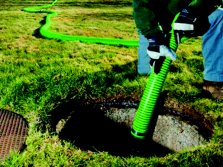Regular Pumping of Cess Pit not only reduces the Cost of Operation but also saves you from Legal Action.
CleanAll Solutions provides you with Cess Pit Maintenance Services using powerful Vacuum Suction Trucks to remove sludge. From up to 25ft depth without anyone getting in direct contact with the waste.
Usually, the Cesspit needs to be cleaned after every 45 days. In case of irregular emptying, Cesspit becomes full and starts to back up. Overflowing is a common problem with cesspits. And can cause issues regarding cracked walls and punctures which, in turn, may lead to external leaks.
A cesspit is a sealed, fully-enclosed tank that collects and stores sewerage. It is basically a holding tank, for the handling of waste at a suitable distance from the waste source and is applicable where municipal drains are not available to collect waste. Such as sites close to water sources or drinking water supplies. Cesspits do not have outlets. Everything that goes in, stays in and has to be removed by a vacuum tanker.
Traditionally, it was a deep cylindrical chamber dug into the earth, having approximate dimensions of 1-meter diameter and 2–3 meters depth. Their appearance was like that of a hand-dug water well.
Depending on the size of the tank, the property and the number of occupants, the cesspit can fill up quickly and needs to be emptied regularly; at monthly, quarterly or annual intervals as required.
A cesspool requires emptying on a very frequent basis around 45 days or so, depending on use or when it is almost full. Its average cost depends upon a number of factors including a distance of disposal site from the service provider.
Standard sizes range from 18,000 liters to 84,000 liters, however larger tanks up to 220,000 liters are available.
All cesspits should have an alarm fitted to indicate when they require emptying. This should be the only method of checking the level in the cesspit, as opening a lid can release dangerous and noxious gases that can overcome someone very quickly.
